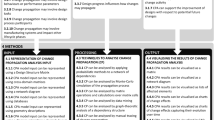Abstract
A pervasive problem for engineering change management is the phenomenon of change propagation by which a change to one part or element of a design requires additional changes throughout the product. This paper introduces a multilayer network model integrating three coupled layers, or domains, of product development that contribute to change propagation: namely, the product layer, change layer, and social layer. The model constitutes a holistic, data-driven approach to the analysis and management of change propagation. A baseline repository of tools and metrics is developed for the analysis and management of change propagation using the model. The repository includes a few novel tools and metrics, most notably the Engineer Change Propagation Index (Engineer-CPI) and Propagation Directness (PD), as well as others already existing in the literature. As such, the multilayer network model unifies previous research on change propagation in a comprehensive paradigm. A case study of a large technical program, which managed over 41,000 change requests in 8 years, is employed to demonstrate the model’s practical utility. Most significantly, the case study explores the program’s social layer and discovers a correspondence between the propagation effects of an engineer’s work and factors such as his/her organizational role and the context of his/her assignments. The study also reveals that parent–child propagation often spanned two or more product interfaces, thus confirming the counterintuitive possibility of indirect propagation between nonadjacent product components or subsystems. Finally, the study finds that most changes did not lead to any propagation. Propagation that did occur always stopped after five, and rarely more than four, generations of descendants.


















Similar content being viewed by others
Notes
Otherwise it can be confusing whether the term “propagation” refers to a single instance or repeated instances of parent–child propagation.
Giffin et al. (2009) actually name this tool the Change DSM or DDSM, but this paper substitutes the word “propagation” for “change” to help distinguish it from a DSM used to represent a change network.
Abbreviations
- CAI:
-
Change Acceptance Index
- CPI:
-
Change Propagation Index
- CPM:
-
Change Prediction Method
- CR:
-
Change request
- CRI:
-
Change Reflection Index
- DMM:
-
Domain Mapping Matrix
- DSM:
-
Design Structure Matrix
- ECM:
-
Engineering change management
- ESM:
-
Engineering Systems Matrix
- IPT:
-
Integrated program team
- PAR:
-
Proposal Acceptance Rate
- PD:
-
Propagation Directness
- PDSM:
-
Propagation Design Structure Matrix
- SAP:
-
System Adjustable Parameter
References
Bartolomei J (2007) Qualitative knowledge construction for engineering systems: extending the design structure matrix methodology in scope and procedure. Dissertation, Massachusetts Institute of Technology
Browning TR (2001) Applying the design structure matrix to system decomposition and integration problems: a review and new directions. IEEE Trans Eng Manag 48(3):292–306
Clarkson PJ, Simons C, Eckert C (2004) Predicting change propagation in complex design. Trans ASME 126:788–797
Danilovic M, Browning TR (2007) Managing complex product development projects with design structure matrices and domain mapping matrices. Int J Manag 25:300–314
Diestel R (2005) Graph theory, 3rd edn. Springer, New York
Earl C, Eckert C, Clarkson J (2005) Design change and complexity. In: 2nd workshop on complexity in design and engineering
Eckert C, Clarkson P, Zanker W (2004) Change and customization in complex engineering domains. Res Eng Design 15:1–21
Eppinger SD (2001) Patterns of product development interactions. In: 13th international conference on engineering design
Eppinger S, Whitney D, Smith R, Gebala D (1994) A model-based method for organizing tasks in product development. Res Eng Design 6(1):1–21
Giffin M (2007) Change propagation in large technical systems. Thesis, Massachusetts Institute of Technology
Giffin M, de Weck O, Bounova G, Keller R, Eckert C, Clarkson J (2009) Change propagation analysis in complex technical systems. J Mech Des 131(8):081010
Huang GQ, Mak KL (1999) Current practices of engineering change management in UK manufacturing industries. Int J Oper Prod Manag 19(1):21
Jarratt T, Eckert C, Clarkson J (2006) Pitfalls of engineering change: change practice during complex product design. Adv Des 413–424
Keller R, Eger T, Eckert CM, Clarkson PJ (2005) Visualizing change propagation. In: 15th international conference on engineering design, pp 62–63
Morelli MD, Eppinger SD, Gulati RK (1995) Predicting technical communication in product development organizations. IEEE Trans Eng Manag 42(2):215–222
N.A.S.A. (2007) NASA systems engineering handbook. SP-2007-6105 R1
Newman J (2003) The structure and function of complex networks. Soc Ind Appl Math 42(2):167–256
Nichols K (1990) Getting engineering changes under control. J Eng Des 1(1):1–6
Pikosz P, Malmqvist J (1998) A comparative study of engineering change management in three Swedish companies. In: Proceedings of the DETC98 ASME design engineering technical conference, pp 78–85
Sosa ME, Eppinger SD, Rowles CM (2000) Understanding the effects of product architecture on technical communication in product development organizations. Massachusetts Institute of Technology Sloan School of Management Working Paper 4130
Sosa ME, Eppinger SD, Rowles CM (2007) Are your engineers talking to one another when they should? Harvard Bus Rev 85(11):133–142
Steward DV (1981) The design structure system: a method for managing the design of complex systems. IEEE Trans Eng Manag 28(3):71–74
Suh ES, de Weck OL (2007) Flexible product platforms: framework and case study. Res Eng Design 18(2):67–89
Terwiesch C, Loch C (1999) Managing the process of engineering change orders: the case of the climate control system in automobile development. J Prod Innov Manag 16:160–172
Wright IC (1997) A review of research into engineering change management: implications for product design. Des Stud 18:33–42
Acknowledgment
Excerpts and figures from this paper were previously published by the Design Society in: Pasqual, MC, de Weck, OL (2011) Multilayer network model for analysis and management of change propagation. In: Proceedings of the 18th International Conference on Engineering Design, pp 126–138.
Author information
Authors and Affiliations
Corresponding author
Rights and permissions
About this article
Cite this article
Pasqual, M.C., de Weck, O.L. Multilayer network model for analysis and management of change propagation. Res Eng Design 23, 305–328 (2012). https://doi.org/10.1007/s00163-011-0125-6
Received:
Revised:
Accepted:
Published:
Issue Date:
DOI: https://doi.org/10.1007/s00163-011-0125-6




